- ข้อความแจ้งเตือน “สินค้าหมดสต็อก” เพิ่มขึ้น 172 เปอร์เซ็นต์
- “ซื้อก่อน จ่ายทีหลัง” กลายเป็นเทรนด์ยอดนิยมในหมู่ผู้บริโภค
- แจกส่วนลดเร็วขึ้น แต่มูลค่าลดลง — Cyber Monday จะยังคงเป็นวันที่มียอดขายสูงสุดในรอบปี (11.3 พันล้านดอลลาร์สหรัฐฯ)
วันนี้อะโดบีได้เผยแพร่ข้อมูลคาดการณ์เกี่ยวกับช้อปปิ้งออนไลน์ สำหรับช่วงเทศกาลปลายปี 2564 (1 พฤศจิกายน – 31 ธันวาคม) โดยเป็นส่วนหนึ่งของรายงานดัชนีเศรษฐกิจดิจิทัลของอะโดบี (Adobe Digital Economy Index) ซึ่งข้อมูลที่เกี่ยวกับอี-คอมเมิร์ซในสหรัฐฯ และทั่วโลกนั้นได้จากการวิเคราะห์ข้อมูลธุรกรรมออนไลน์ของผู้บริโภคโดยตรง (direct consumer transactions online) ทั้งนี้ รายงานวิเคราะห์ดังกล่าวอ้างอิงข้อมูลจาก Adobe Analytics จากการเยี่ยมชมเว็บไซต์ผู้ค้าปลีกของสหรัฐฯ มากกว่าหนึ่งล้านล้านครั้ง รวมถึงสินค้ากว่า 100 ล้านรายการใน 18 หมวดหมู่ ส่วนข้อมูลทั่วโลกนั้นได้จากธุรกรรมกว่า 100 ประเทศใน 3 ภูมิภาค ซึ่งนับเป็นการศึกษาที่ครอบคลุมมากกว่าบริษัทเทคโนโลยี หรือหน่วยงานวิจัยอื่นๆ
อะโดบีคาดการณ์ยอดขายสินค้าออนไลน์ในสหรัฐฯ ช่วงเทศกาลช้อปปิ้งปลายปีจะแตะ 207 พันล้านดอลลาร์ (ประมาณ 6.8 ล้านล้านบาท) ระหว่างวันที่ 1 พฤศจิกายน ถึง 31 ธันวาคม ซึ่งนับเป็นสถิติใหม่ โดยเพิ่มขึ้น 10 เปอร์เซ็นต์จากปี 2653 และถือเป็นอัตราการเติบโตที่แข็งแกร่งหลังจากหนึ่งปีที่สถานการณ์การแพร่ระบาดส่งผลให้อี-คอมเมิร์ซกลายเซอร์วิสที่มีความจำเป็นต่อผู้บริโภค ขณะที่ยอดใช้จ่ายออนไลน์ทั่วโลกอาจแตะ 910 พันล้านดอลลาร์สหรัฐฯ (ประมาณ 30 ล้านล้านบาท) เพิ่มขึ้น 11 เปอร์เซ็นต์เมื่อเทียบกับช่วงเดียวกันของปีที่แล้ว (YoY) นอกจากนี้ อะโดบีคาดการณ์ว่ายอดใช้จ่ายทั่วโลกตลอดปี 2564 จะมากกว่า 4 ล้านล้านดอลลาร์ (ประมาณ 4.1 ล้านล้านดอลลาร์) หรือประมาณ 133 ล้านล้านบาท ซึ่งนับเป็นสถิติใหม่สำหรับอี-คอมเมิร์ซ
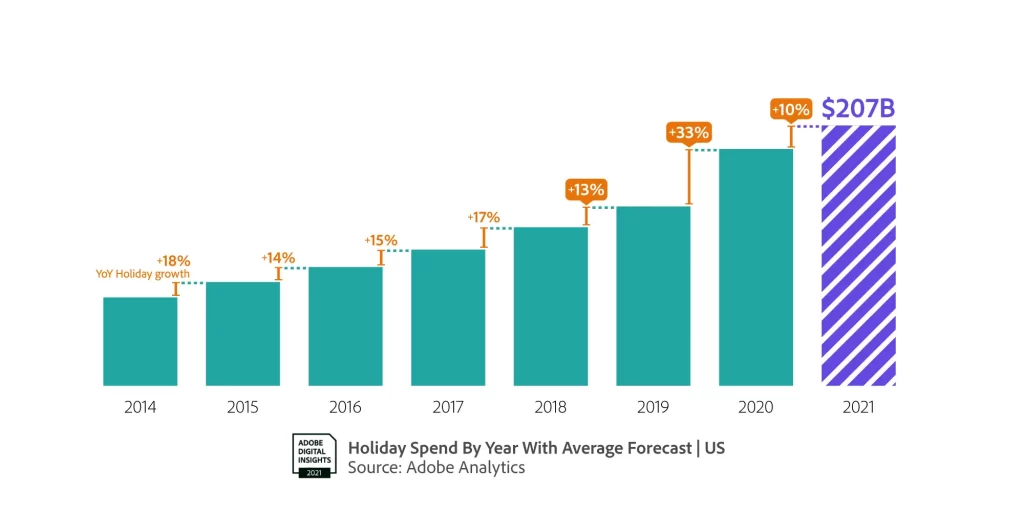
ขณะที่อี-คอมเมิร์ซได้รับความนิยมอย่างแพร่หลายมากขึ้นในสหรัฐฯ แต่ความสนใจช้อปปิ้งในช่วงเทศกาลหลักๆ ได้รับความนิยมน้อยลง ตัวอย่างเช่น ช่วงสัปดาห์ Cyber Week (ช่วงวันขอบคุณพระเจ้าถึงวัน Cyber Monday) คาดว่าจะมียอดใช้จ่ายออนไลน์ 36 พันล้านดอลลาร์สหรัฐฯ คิดเป็น 17 เปอร์เซ็นต์ตลอดเทศกาล อย่างไรก็ตาม อัตราการเติบโตดังกล่าวลดลง โดยอยู่ที่เพียง 5 เปอร์เซ็นต์ YoY สำหรับช่วงระยะเวลา 5 วัน (น้อยกว่าอัตราการเติบโตโดยรวมของช่วงเทศกาล ซึ่งอยู่ที่ 10 เปอร์เซ็นต์ YoY) อะโดบีคาดว่าช่วง Cyber Monday จะมียอดใช้จ่าย 11.3 พันล้านดอลลาร์สหรัฐฯ (เพิ่มขึ้น 4 เปอร์เซ็นต์ YoY) และจะยังคงเป็นวันที่มียอดใช้จ่ายสูงสุดสำหรับเทศกาล ขณะที่ช่วง Black Friday คาดว่าจะมียอดใช้จ่ายอยู่ที่ 9.5 พันล้านดอลลาร์ (เพิ่มขึ้น 5 เปอร์เซ็นต์ YoY) และวันขอบคุณพระเจ้ามียอดใช้จ่ายอยู่ที่ 5.4 พันล้านดอลลาร์ (เพิ่มขึ้น 6 เปอร์เซ็นต์ YoY) วันช้อปปิ้งหลักๆ ทั้งสามวันดังกล่าวมีอัตราการเติบโตน้อยกว่าเทศกาลโดยรวม
ปัญหาด้านซัพพลายเชนส่งผลกระทบต่อเทศกาลช้อปปิ้ง
ความต้องการช้อปปิ้งออนไลน์ของผู้บริโภคที่เพิ่มสูงขึ้น ในขณะที่ผู้ค้าปลีกกำลังประสบปัญหาต่างๆ ในด้านซัพพลายเชน เช่น ปัญหาความหนาแน่นของสินค้าและตู้คอนเทนเนอร์ของท่าเรือ การขนส่งที่ล่าช้า และการผลิตสินค้าในต่างประเทศที่หยุดชะงัก ขณะเดียวกันผู้บริโภคก็รู้สึกได้ถึงผลกระทบที่เกิดขึ้น โดยเมื่อเทียบกับช่วงก่อนที่จะเกิดการแพร่ระบาด (มกราคม 2563) ข้อความแจ้งเตือนว่าสินค้าหมดสต็อกมีจำนวนเพิ่มสูงขึ้นถึง 172 เปอร์เซ็นต์ช่วงเทศกาล ทั้งนี้ อะโดบีคาดการณ์ว่าตัวเลขดังกล่าวจะยังคงทรงตัวอยู่ในระดับนี้ต่อไป และอาจเพิ่มขึ้นสำหรับสินค้าบางรายการตลอดช่วงเทศกาล จากสินค้า 18 หมวดหมู่ที่อะโดบีทำการตรวจสอบ พบว่าในปัจจุบัน สินค้าประเภทเครื่องแต่งกายเป็นสินค้าที่หมดสต็อกมากที่สุด ตามด้วยสินค้าประเภทอุปกรณ์กีฬา ผลิตภัณฑ์สำหรับทารก และสินค้าอิเล็กทรอนิกส์
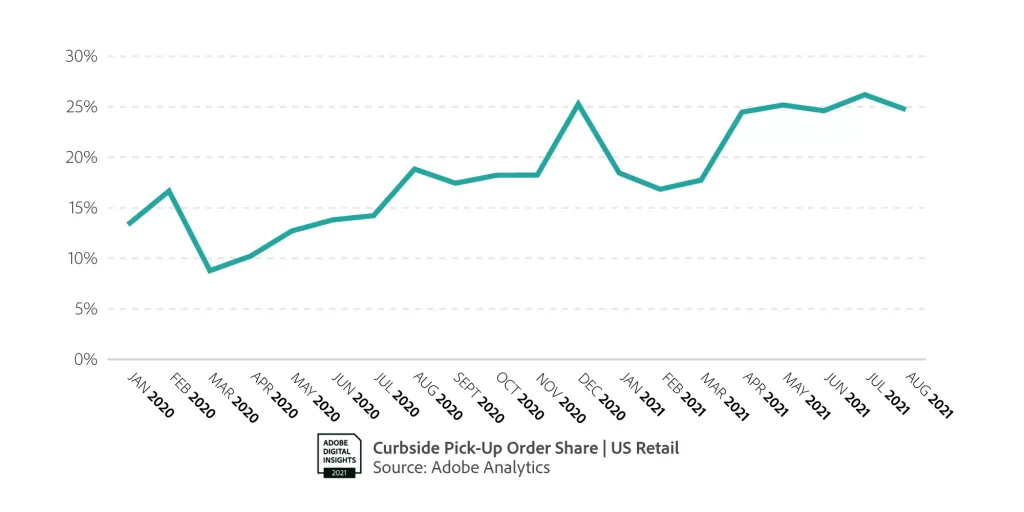
นอกจากนี้ ปัญหาซัพพลายเชนก็ส่งผลให้ราคาสินค้าออนไลน์ปรับสูงขึ้น โดยอะโดบีคาดว่าผู้บริโภคในสหรัฐฯ จะต้องจ่ายเงินเพิ่มขึ้นโดยเฉลี่ย 9 เปอร์เซ็นต์ในช่วง Cyber Week ของปีนี้ เมื่อเทียบกับช่วงเดียวกันของปีที่แล้ว ซึ่งเป็นผลมาจากส่วนลดที่น้อยลง อีกทั้งยังเกิดสถานการณ์เงินเฟ้อในภาคธุรกิจอี-คอมเมิร์ซ ซึ่งเป็นปัญหายืดเยื้อที่เกิดขึ้นมาอย่างต่อเนื่องตลอดทั้งปี อะโดบีคาดว่าส่วนลดจะอยู่ที่ 5 เปอร์เซ็นต์ ถึง 25 เปอร์เซ็นต์สำหรับสินค้าหมวดหมู่ต่างๆ ในช่วงปลายปีนี้ เปรียบเทียบกับส่วนลดโดยเฉลี่ย 10 เปอร์เซ็นต์ ถึง 30 เปอร์เซ็นต์ในปีที่ผ่านมา
กรณีดังกล่าวสืบเนื่องมาจากราคาสินค้าปรับตัวสูงขึ้น โดยเป็นผลมาจากสถานการณ์เงินเฟ้อในภาคธุรกิจอี-คอมเมิร์ซ ซึ่งเกิดขึ้นตั้งแต่เดือนมิถุนายน 2563 (16 เดือนติดต่อกัน) โดยราคาสินค้าออนไลน์เพิ่มสูงขึ้น 3.3 เปอร์เซ็นต์ในช่วงเริ่มเข้าสู่เทศกาลปลายปี (กันยายน 2564) หลายปีที่ผ่านมา ราคาสินค้าออนไลน์ลดลงโดยเฉลี่ย 5 เปอร์เซ็นต์ YoY ก่อนที่จะเข้าสู่ช่วงเทศกาลปลายปี อย่างไรก็ตาม ราคาสินค้าอี-คอมเมิร์ซไม่ได้เพิ่มสูงขึ้นเร็วเท่าสินค้าออฟไลน์ อย่างไรก็ตามดัชนีราคาผู้บริโภค (Consumer Price Index) ล่าสุดเพิ่มขึ้น 5.4 เปอร์เซ็นต์ YoY (กันยายน 2021)
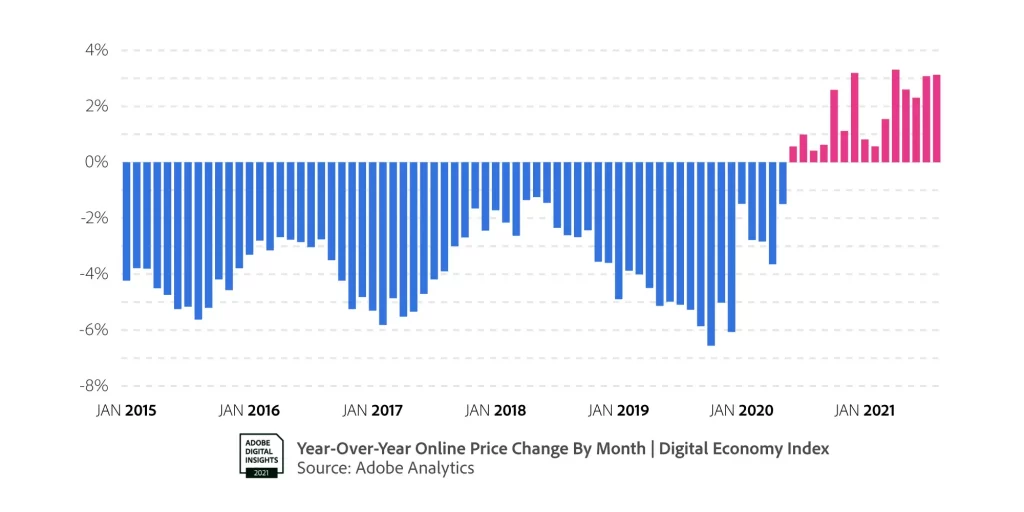
แพทริค บราวน์ รองประธานฝ่ายการตลาดและข้อมูลเชิงลึกของอะโดบี กล่าวว่า “เทศกาลช้อปปิ้งปลายปีกำลังกลับมาอีกครั้งภายใต้สถานการณ์การแพร่ระบาด การที่มีสินค้าจำนวนจำกัด ราคาสินค้าที่แพงขึ้น และความกังวลของผู้บริโภคกับการขนส่งที่ล่าช้าทำให้อี-คอมเมิร์ซเติบโตสูงขึ้นอีกครั้ง เพราะช่องทางดังกล่าวสามารถสร้างความยืดหยุ่นแก่ผู้บริโภคในการเลือกซื้อสินค้า และเลือกช่วงเวลาที่ซื้อได้”
ข้อมูลเชิงลึกเกี่ยวกับส่วนลด และช่วงวันที่เหมาะกับการช้อปปิังมากที่สุด:
ส่วนลดตามหมวดหมู่สินค้า: อะโดบีคาดว่าสินค้าทุกประเภทที่นิยมให้เป็นของขวัญจะมีส่วนลดน้อยลง ตามข้อมูลจากดัชนีเศรษฐกิจดิจิทัล ตัวอย่างเช่น สินค้าอิเล็กทรอนิกส์จะลดสูงสุดได้เพียง 22 เปอร์เซ็นต์สำหรับช่วงเทศกาลปลายปี ลดลงจาก 27 เปอร์เซ็นต์ในปี 2563 ส่วนสินค้าประเภทอื่นๆ ได้แก่ คอมพิวเตอร์มีส่วนลดสูงสุดอยู่ที่ 25 เปอร์เซ็นต์ (เทียบกับ 30 เปอร์เซ็นต์ในปี 2563), โทรทัศน์ 15 เปอร์เซ็นต์ (เทียบกับ 18 เปอร์เซ็นต์), เครื่องใช้ไฟฟ้า 16 เปอร์เซ็นต์ (เทียบกับ 20 เปอร์เซ็นต์), ของเล่น 16 เปอร์เซ็นต์ (เทียบกับ 19 เปอร์เซ็นต์), สินค้าประเภทเครื่องกีฬา 14 เปอร์เซ็นต์ (เทียบกับ 20 เปอร์เซ็นต์), เครื่องแต่งกาย 15 เปอร์เซ็นต์ (เทียบกับ 20 เปอร์เซ็นต์), เฟอร์นิเจอร์ 7 เปอร์เซ็นต์ (เทียบกับ 9 เปอร์เซ็นต์) และอุปกรณ์เครื่องมือ 8 เปอร์เซ็นต์ (เทียบกับ 11 เปอร์เซ็นต์)
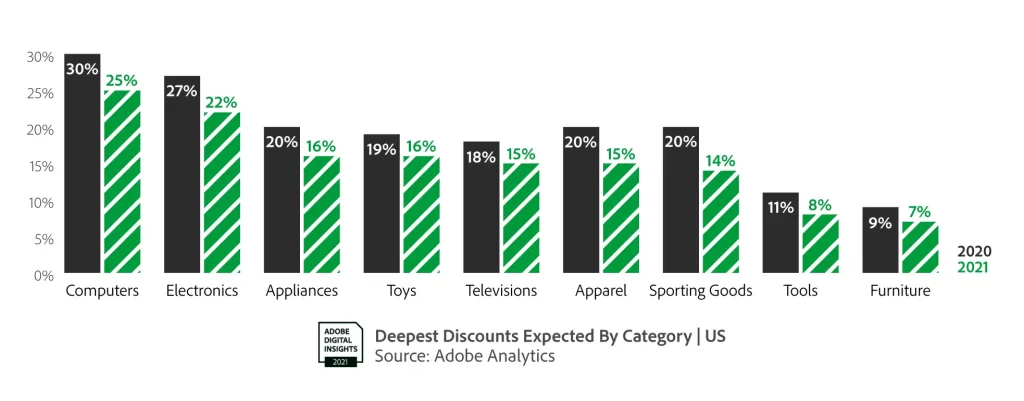
ช่วงเวลาที่เหมาะแก่การช้อป: อะโดบีได้ทำการสำรวจความคิดเห็นของผู้บริโภคกว่า 1,000 คนในสหรัฐฯ และพบว่า 67 เปอร์เซ็นต์รู้สึกเป็นกังวลว่าในปีนี้ของขวัญจะมีราคาแพงขึ้น ส่วนลดช่วงเทศกาลคาดว่าจะเริ่มต้นในเดือนตุลาคม โดยอยู่ในช่วง 5 เปอร์เซ็นต์ ถึง 15 เปอร์เซ็นต์ ขณะที่ผู้ค้าปลีกกำลังมองหาหนทางที่จะแก้ไขปัญหาท้าทายด้านซัพพลายเชน อย่างไรก็ดี ส่วนลดสูงสุด (5 เปอร์เซ็นต์ ถึง 25 เปอร์เซ็นต์) คาดว่าจะยังคงเกิดขึ้นในช่วงวันขอบคุณพระเจ้าและ Cyber Monday
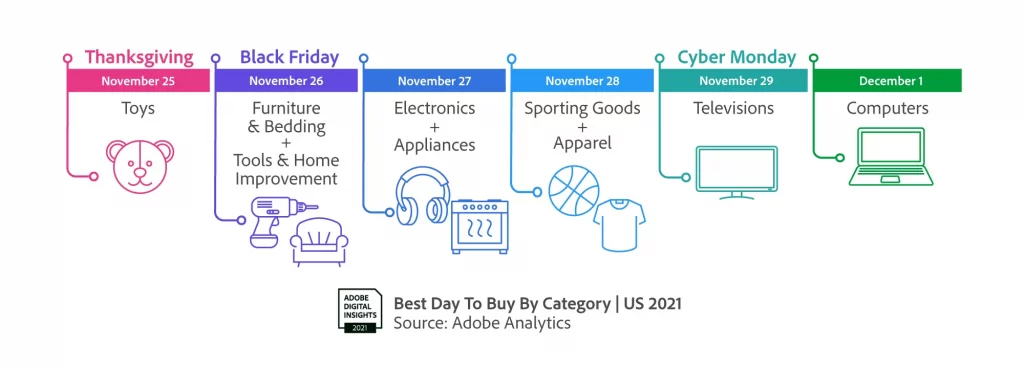
สินค้าบางประเภท เช่น สินค้าอิเล็กทรอนิกส์ คาดว่าจะมีส่วนลดสูงสุดก่อนวัน Cyber Monday ส่วนช่วงวันที่เหมาะแก่การช้อปสินค้าประเภทต่างๆ ได้แก่ วันขอบคุณพระเจ้า (25 พ.ย.) สำหรับของเล่น, Black Friday (26 พ.ย.) สำหรับเฟอร์นิเจอร์/เครื่องนอน และเครื่องมือ/อุปกรณ์แต่งบ้าน, วันเสาร์ (27 พ.ย.) สำหรับสินค้าอิเล็กทรอนิกส์และเครื่องใช้ไฟฟ้า, วันอาทิตย์ (28 พ.ย.) สำหรับเครื่องแต่งกายและสินค้าประเภทเครื่องกีฬา, Cyber Monday (29 พ.ย.) สำหรับโทรทัศน์ และวันพุธ (1 ธ.ค.) สำหรับคอมพิวเตอร์
อินไซต์เกี่ยวกับบริการซื้อก่อน จ่ายทีหลัง, ของขวัญยอดนิยม, รับสินค้าหน้าร้านแบบไดร์ฟทรู และอื่นๆ:
ซื้อก่อน จ่ายทีหลัง: ผู้บริโภคให้การตอบรับที่ดีต่อรูปแบบการชำระเงินแบบใหม่ที่เรียกว่า “บริการซื้อก่อน จ่ายทีหลัง (Buy Now Pay Later – BNPL)” ซึ่งจะช่วยเพิ่มเงินสดหมุนเวียนสำหรับการจับจ่ายใช้สอยในช่วงเทศกาลปลายปี รายได้ออนไลน์จาก BNPL ในปีนี้เพิ่มขึ้น 10 เปอร์เซ็นต์เมื่อเทียบกับปี 2563 และเพิ่มขึ้น 45 เปอร์เซ็นต์เมื่อเทียบกับปี 2562 ตามข้อมูลจาก Adobe Analytics นอกจากนั้น ผู้บริโภคยังใช้บริการ BNPL สำหรับสินค้าที่มีราคาสูงน้อยลง โดยมูลค่าขั้นต่ำของคำสั่งซื้อลดลง 12 เปอร์เซ็นต์ YoY ไปอยู่ที่ 225 ดอลลาร์ ทั้งนี้ จากการสำรวจของอะโดบี พบว่าผู้ตอบแบบสอบถาม 25 เปอร์เซ็นต์ใช้บริการ BNPL ในช่วง 3 เดือนที่ผ่านมา โดยสินค้าหมวดเครื่องแต่งกาย (ระบุโดยผู้ตอบแบบสอบถาม 43 เปอร์เซ็นต์), สินค้าอิเล็กทรอนิกส์ (33 เปอร์เซ็นต์) และของชำ (30 เปอร์เซ็นต์) เป็นหมวดหมู่สินค้าที่มีการใช้บริการดังกล่าวมากที่สุด
บริการรับสินค้าหน้าร้านแบบไดร์ฟทรู กลายเป็นดาวเด่นอีกครั้ง: ในเดือนธันวาคม 2563 มีการใช้บริการรับสินค้าที่สั่งซื้อทางออนไลน์จากร้านค้าแบบไดร์ฟทรู (Curbside Pickup) ราว 25 เปอร์เซ็นต์ของคำสั่งซื้อออนไลน์ทั้งหมด เนื่องจากผู้บริโภคมองหาวิธีการช้อปปิ้งอย่างปลอดภัย และในช่วงเทศกาลปลายปีที่กำลังจะมาถึง คาดว่าปัญหาความล่าช้าในการจัดส่งจะทำให้ผู้บริโภคหันมาใช้บริการนี้เพิ่มมากขึ้น โดยจากผลการสำรวจของอะโดบี ชี้ว่า 65 เปอร์เซ็นต์ของผู้บริโภคมีความกังวลใจเกี่ยวกับความล่าช้าในการจัดส่งสินค้า และอะโดบีคาดว่าบริการ Curbside Pickup จะมียอดใช้งานสูงสุดในช่วงวันที่ 22-23 ธันวาคม (ก่อนวันคริสต์มาสอีฟ) โดยจะทำสถิติสูงสุดที่ 40 เปอร์เซ็นต์ของคำสั่งซื้อออนไลน์ทั้งหมด แต่ในเดือนพฤศจิกายน 2564 คาดว่าอัตราการใช้บริการจะทรงตัวอยู่ที่ 25 เปอร์เซ็นต์
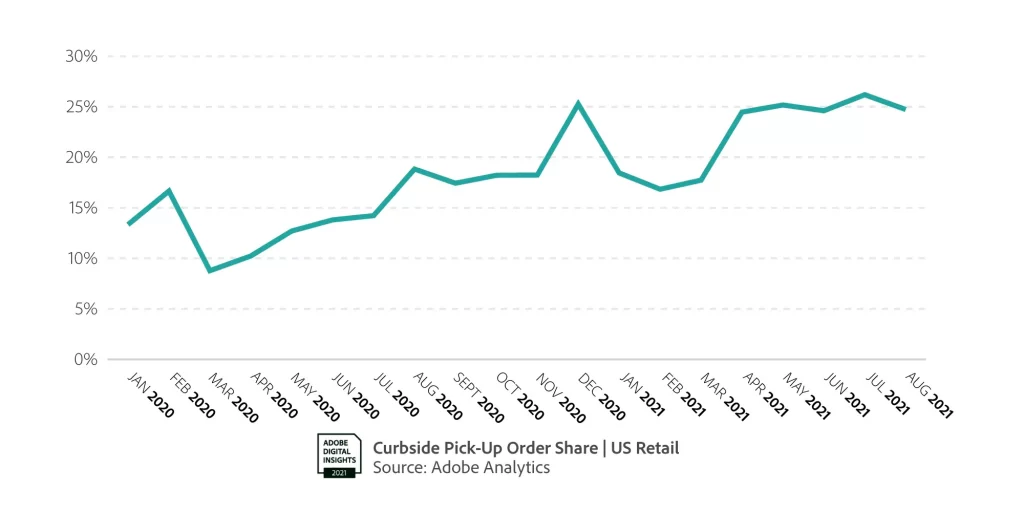
ของขวัญยอดนิยม: จากข้อมูลของอะโดบี รวมถึงข้อมูลวิเคราะห์แนวโน้มตลาดและกระแสโซเชียลมีเดีย คาดว่าของเล่นยอดนิยมในช่วงเทศกาลปลายปีได้แก่ Tamagotchi Pix, Pop Fidget, Got2Glow Fairy Finder, Baby Yoda, และ Gabby’s Dollhouse ส่วนอุปกรณ์เล่นเกมยอดนิยมได้แก่ Nintendo Switch OLED, PlayStation 5, Xbox Series S/X และ Stream Deck ขณะที่เกมยอดนิยมคาดว่าจะเป็น Metroid Dread, Battlefield 2042, Pokemon Brilliant Diamond & Shining Pearl, Halo Infinite และ FIFA 22 ส่วนของขวัญยอดนิยมอื่นๆ ได้แก่ Airpods Max, ถ้วยกาแฟอัจฉริยะ, หม้ออเนกประสงค์ Instant Pot, หม้อทอดไร้น้ำมัน, กระบอกน้ำอัจฉริยะ, โดรน และเครื่องเล่นแผ่นเสียง
ให้ความสนใจหน้าจอที่ใหญ่ขึ้น: ปัจจุบันผู้บริโภคใช้เวลาอยู่บ้านและทำงานหน้าแล็ปท็อปมากขึ้น ส่งผลให้ยอดช้อปปิ้งของสมาร์ทโฟนไม่มากนัก อะโดบีคาดว่ายอดซื้อสมาร์ทโฟนจะครองสัดส่วน 42 เปอร์เซ็นต์ของรายได้โดยรวมในช่วงเทศกาลปลายปีนี้ (86 พันล้านดอลลาร์สหรัฐฯ) และเพิ่มขึ้น 5 เปอร์เซ็นต์จากปี 2563
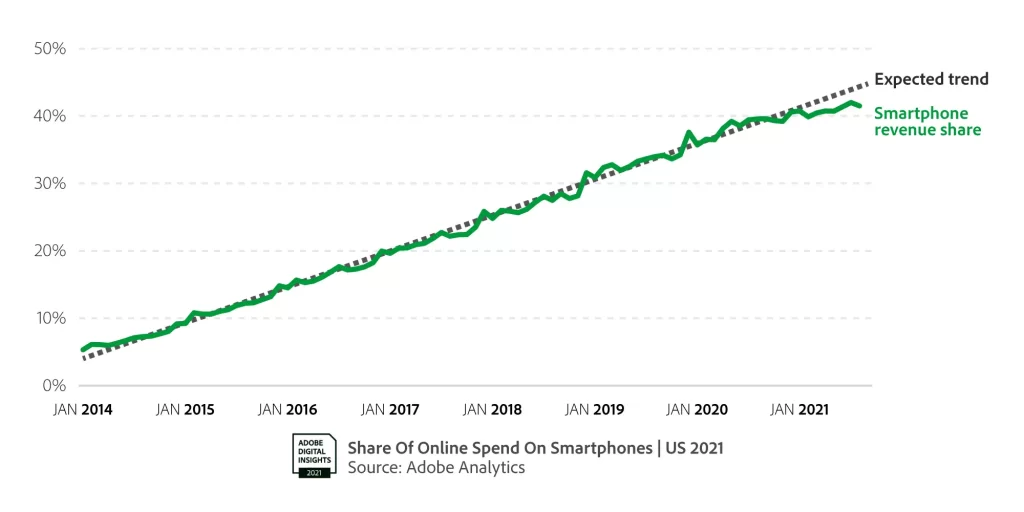
การใช้เวลาอยู่ที่บ้านมากขึ้นส่งผลให้ผู้บริโภคสนใจจอทีวีขนาดใหญ่เพิ่มขึ้นด้วยเช่นกัน เพราะต้องการสัมผัสประสบการณ์โฮมเธียเตอร์ โดยความต้องการทีวีขนาด 70-79 นิ้วมีสัดส่วน 22 เปอร์เซ็นต์ของยอดขายในปี 2563 เพิ่มขึ้นจาก 16 เปอร์เซ็นต์ในปี 2562 และ 9 เปอร์เซ็นต์ในปี 2561 ส่วนทีวีขนาด 80 นิ้วขึ้นไปคิดเป็นสัดส่วน 3 เปอร์เซ็นต์ของยอดขายในปี 2563 เพิ่มขึ้นจาก 1 เปอร์เซ็นต์ในปี 2562 และ 1 เปอร์เซ็นต์ในปี 2561
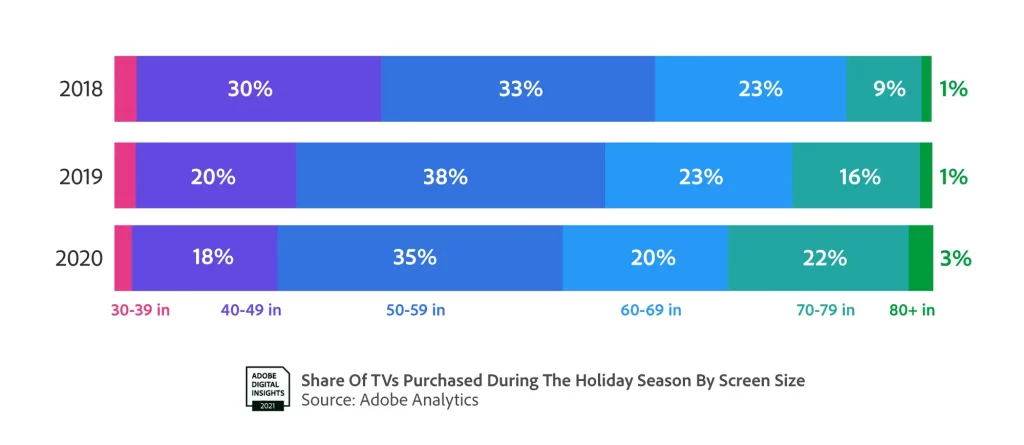
ผู้บริโภคสนุกกับการช้อปปิ้งมากขึ้น: โดยเฉลี่ยแล้ว ผู้บริโภคในสหรัฐฯ จะใช้เวลา 12 ชั่วโมงเต็มไปกับการช้อปออนไลน์ในช่วงเทศกาลปลายปีนี้ โดย “นาทีทอง” ของอี-คอมเมิร์ซ (19:00–23:00 น. ตามเวลาฝั่งแปซิฟิกของวัน Cyber Monday) ผู้บริโภคจะใช้จ่ายเงินเกือบ 3 พันล้านดอลลาร์ผ่านทางออนไลน์ (2.9 พันล้านดอลลาร์) ในช่วงเวลาเพียง 4 ชั่วโมง ซึ่งมากกว่า 50 เปอร์เซ็นต์เมื่อเทียบกับช่วงเวลาหนึ่งวันเต็มตามปกติในเดือนสิงหาคม 2564 (1.9 พันล้านดอลลาร์) และในชั่วโมงที่มียอดขายสูงสุดของ Cyber Monday (20:00–12:00 น. ตามเวลาฝั่งแปซิฟิก) ผู้บริโภคจะใช้จ่ายเงินกว่า 12 ล้านดอลลาร์สหรัฐฯ ในทุกๆ หนึ่งนาที
“ประสบการณ์” คือของขวัญชิ้นใหม่: จากผลการสำรวจของอะโดบี พบว่าผู้ตอบแบบสอบถามกว่าครึ่งหนึ่ง (51 เปอร์เซ็นต์) มีแผนที่จะซื้อสินค้าที่จับต้องได้เป็นของขวัญให้แก่คนอื่นๆ ในช่วงเทศกาลปลายปีนี้ ขณะที่เกือบหนึ่งในห้า (17 เปอร์เซ็นต์) มีแผนที่จะให้ของขวัญในรูปแบบของประสบการณ์แทน โดยของขวัญยอดนิยมจำพวกนี้ได้แก่ บริการสปา ทรีทเมนต์ (ระบุโดยผู้ตอบแบบสอบถาม 25 เปอร์เซ็นต์), ตั๋วคอนเสิร์ต (25 เปอร์เซ็นต์), ตั๋วชมการแข่งขันกีฬา (22 เปอร์เซ็นต์), ตั๋วเครื่องบิน (21 เปอร์เซ็นต์) และคอร์สเรียนทำอาหาร (16 เปอร์เซ็นต์)
ระเบียบวิธีที่ใช้ในการศึกษา: ดัชนีเศรษฐกิจดิจิทัลของอะโดบีนำเสนอชุดข้อมูลเชิงลึกที่ครบถ้วนสมบูรณ์มากที่สุด โดยอ้างอิงข้อมูลวิเคราะห์จาก Adobe Analytics ซึ่งครอบคลุมการ visit เว็บไซต์ค้าปลีกในสหรัฐฯ มากกว่าหนึ่งล้านล้านครั้ง และสินค้ากว่า 100 ล้านรายการใน 18 หมวดหมู่ ซึ่งนับเป็นข้อมูลที่มากกว่าบริษัทเทคโนโลยีหรือหน่วยงานวิจัยอื่นๆ นอกจากนี้ ข้อมูลทั่วโลกได้อ้างอิงธุรกรรมในกว่า 100 ประเทศในทวีปอเมริกา, เอเชีย-แปซิฟิก (APAC), ยุโรป ตะวันออกกลาง และแอฟริกา (EMEA) ข้อมูลสำรวจความคิดเห็นจากการตอบแบบสอบถามของผู้บริโภค (อายุเกินกว่า 18 ปี) ในสหรัฐฯ 1,012 คน ในช่วงวันที่ 23 กันยายน ถึง 1 ตุลาคมที่ผ่านมา
